Broadly, balance may be described as an “equipoise between contrasting, opposing, or interacting elements.” It may be static (still) or dynamic (changing). It may relate to forces, mind, or matter. Balance is often in tandem with proportionality, which expresses the relative contributions of participating elements.
In a gravitational field, balance is a description of the distribution of weight around a vertical axis. Our sense of vertical in the world around us, up and down, arises due to the force of gravity. The force of gravity is directed toward the center of the earth.
The perception and experience of gravity comes through the senses. We describe it as the weight in our bodies and in objects. In motion we experience gravity as the tendency to speed up when walking down a hill. Falling is a dramatic and often traumatic experience of the force of gravity.
Balance System
Our perception of gravity is bound together with a mechanism in our bodies called the balance system. The balance system enables a person to control horizontal and vertical orientation in space. When a person says “I lost my balance” what is actually being described is a breakdown in one or more components of the balance system.
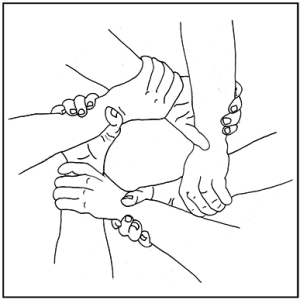
Synergistic System
The tangible sense of “balance” that we experience is a synergy that results from the combination of balance system components. A basic understanding of the balance control system can help lower the risk of falling. Knowing something about the components of the balance system and some simple ways to keep them strong should be a component of basic personal health maintenance.

We go in and out of balance all the time. When the system works properly, we are able to quickly sense changes in posture and catch our balance. If we do lose balance and fall, training can help us avoid or reduce injury.
Overview of the Balance System
Broadly, the components of the balance system can be categorized in the following way: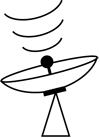
- Information: Balance control is dependent on information gathered by our senses. Information takes various forms such as vision, or sensations like touch, pressure and tension. The inner ear, also called the vestibular system, senses orientation – up from down, and movement. Spatial awareness, also called proprioception, arises by combining sensory information to produce a three dimensional awareness and map of the space around our bodies.
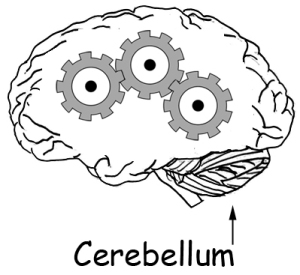
- Processing: The information from our senses must be interpreted and combined. That is the function of the central nervous system, especially an area in the brain called the cerebellum.
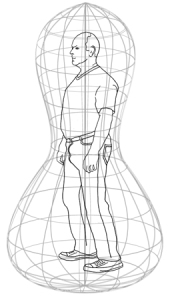
- Movement: Instructions for movement must be transmitted to the muscles. Transmission of the instructions is the job of the peripheral nervous system. Execution of instructions is the job of the musculoskeletal system.
- Feedback: Information must be constantly updated and movement adjusted as conditions change. The feedback process produces a state of balance.

Diagram of the balance system illustrating the importance of information obtained from various sensory systems. Information must be processed and integrated by the brain in order to control balance and movement.
Information
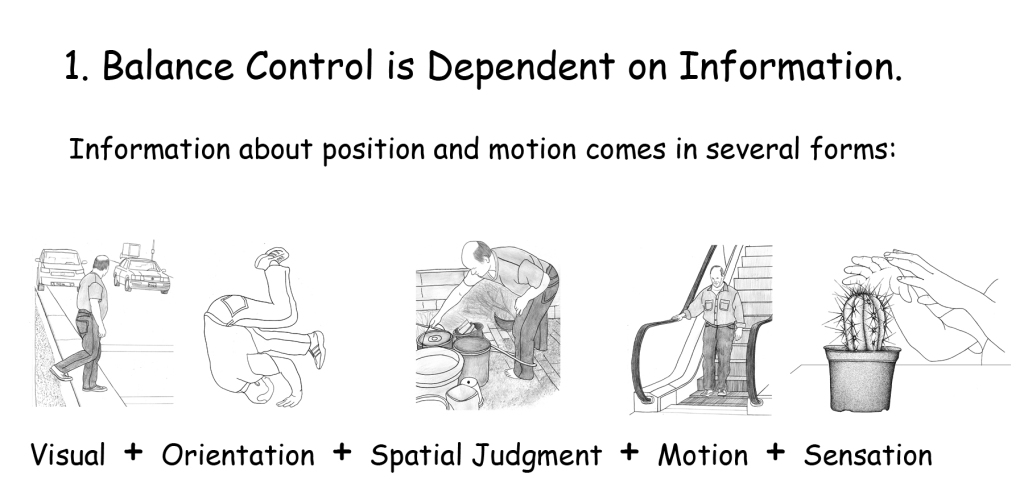
The accuracy of information obtained through the senses is critical for balance control. In order to cross a street safely, visual judgments about speed and distance must be correlated with information about movement and position. The senses must be in good working order.
Processing
The speed and accuracy with which we process information is linked to our capacity to sense, form judgments, and react by altering a movement pattern. We must be aware of our actions in the present moment and also be planning for what comes next. A change in surface, such as transitioning from a sidewalk to grass requires present moment awareness and future planning. This advanced planning must happen while we are in motion!
Most of the time we are not consciously thinking about our balance. Balance control operates in the background. When something changes we respond – when the system is healthy. Since this responsiveness depends on how quickly we can process information, it is worth examining our movement habits. If we move too quickly, critical information such as a hazard may be missed, thereby diminishing the capacity to move safely and recover from a loss of balance.
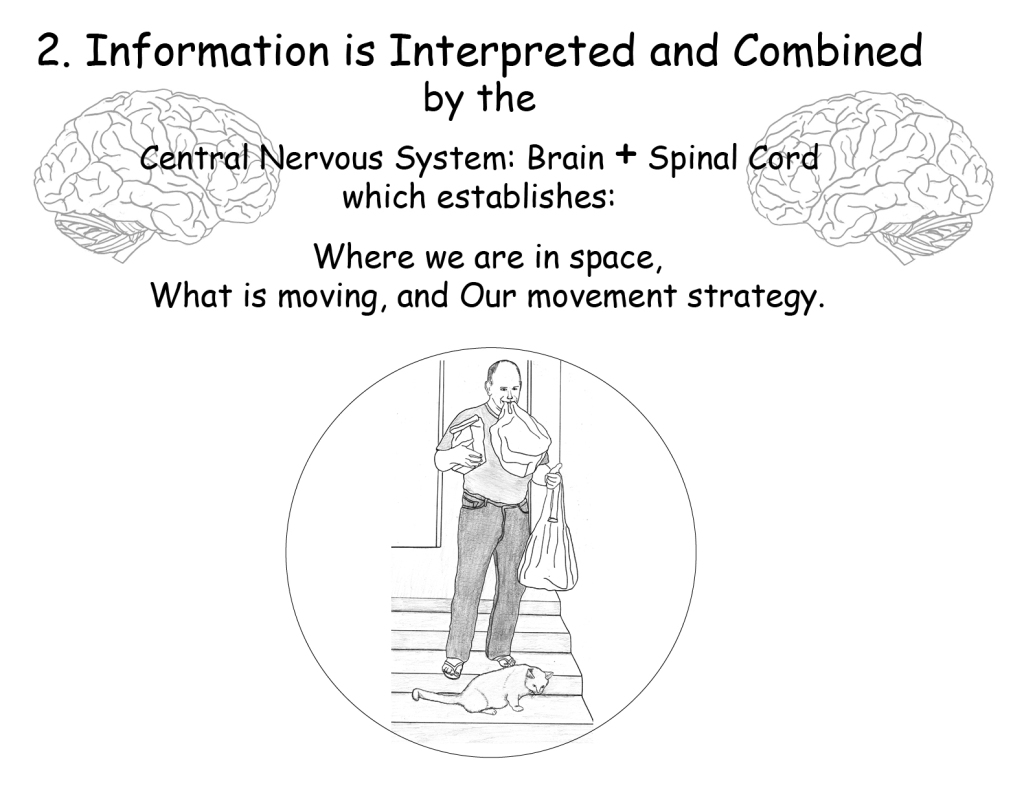
Balance control is an on going process. We are constantly gathering, interpreting and combining sensory information. The information is formed into instructions that are then sent to the muscles for action. That process takes time. The amount of time is dependent on how quickly we can process information, the level of distraction, concentration, and any factors that may limit movement such as injury or environmental factors like a cracked and uneven sidewalk. The more we multitask, the greater the need for concentration and quick processing. Slowing down and reducing complexity (unlike the figure above!) are immediate solutions for improving balance control.
Movement and Control
A control system is a combination of linked components which produces an effect that can be varied. The automobile steering mechanism is an example of a control system. Turning the steering wheel changes the position of the wheels on the road and thus alters the direction of travel. Similarly, balance is a control system made up of acquired information, processing, judgment, and finally, the execution of instructions that result in movement.

Balance control helps us to sustain fluid and safe patterns of movement. Since balance results from a chain of components, it will only be as strong as the weakest link. Often it is the muscles that are the weakest link. Strength training is therefore a critical part of maintaining healthy balance.
Feedback
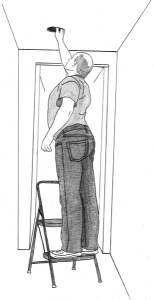
Balance Control
A control system requires feedback. When we steer a car the visual sense helps determine the new direction. Based on what we see (the feedback), we make corrections such as staying in the proper lane or avoiding a pothole. At the same time our inner ear (also called the vestibular system) and pressure sensors in our skin register the motion of the car in our bodies. If it feels like we are going too fast we may apply the brakes as a secondary control.
Balance is a state of physical alignment combined with a feeling composed of motion and poise. The state of balance is sustained by the constant interplay between sense and action. The constant interplay is the feedback.
There are many factors, internal and environmental, that can influence our state of balance. When one part of the balance system is not functioning properly due to limited information or damage, other parts of the system must compensate for the deficit by working harder. If the system isn’t up to the task, balance will suffer.

The feedback process can be compromised when information is limited. For example: when we have insufficient light combined with poor vision there is a greater demand on the inner ear for information about posture and motion. However, if the inner ear has also lost some sensitivity we may not have quite enough combined information to feel fully balanced when the light is low. This double loss of sensitivity (vision and inner ear) is common with age and explains why adequate illumination becomes more important for safe movement.
Balance and Stability
As we move there is a marvelous orchestration of body components working to keep us on our feet. The degree to which we are susceptible to balance loss depends on how stable we are at any given moment. Stability is influenced by a variety of factors such as physical and mental fitness, the position of the feet on the ground, type of surface, shoes, posture, speed and level of distraction – to name just a few.
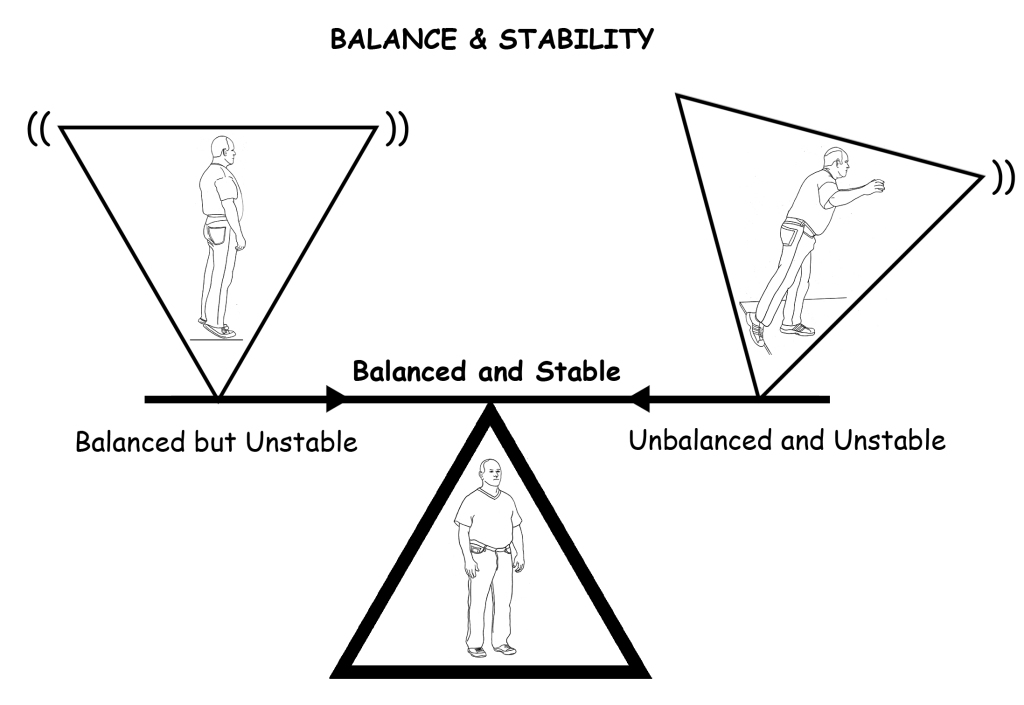
Stability is a way of describing how well something can tolerate stress without falling apart. In the diagram, the different positions project a sense of differing tolerances to stress. The figure on the left is balanced on tip toe but a slight push would tip him over. A healthy balance system is sensitive to changes in stability and able to respond quickly in order to return us to a balanced and stable state.
Improving Balance
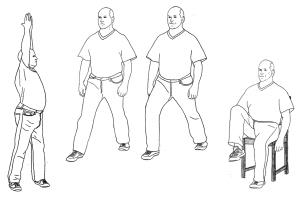
Balance and mobility training can help to restore and maintain functional movement patterns, thereby increasing independence and thus enhancing the quality of our lives.
The fact that the balance system has multiple parts provides more than one path to improvement. This is fortuitous because it means that if any part of the system is strengthened the entire system gets stronger as a result.
If a component of the balance system is weak and cannot be improved due to irreversible damage another area of the system can be strengthened in order to compensate for the deficit. The function of Balance and Mobility Training is to identify specific weaknesses in the balance system and strengthen them, as well as strengthening the system as a whole in order to lower the risk of falling. Feeling stable and safe increases our sense of independence and ultimately enhances quality of life.

Leave a Reply